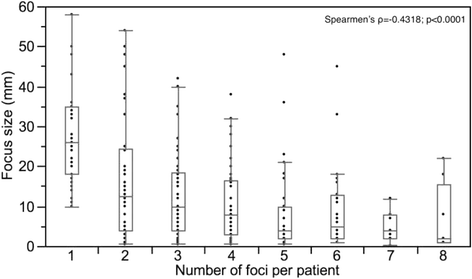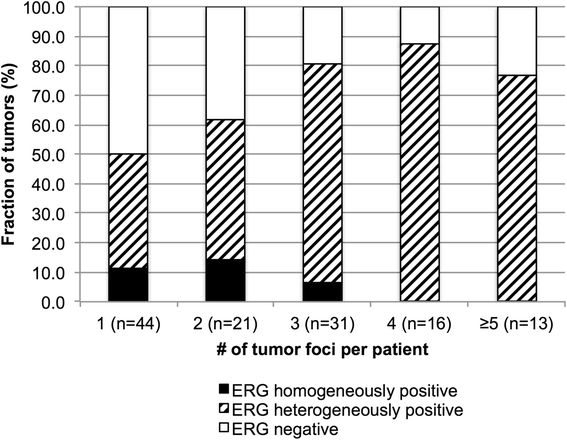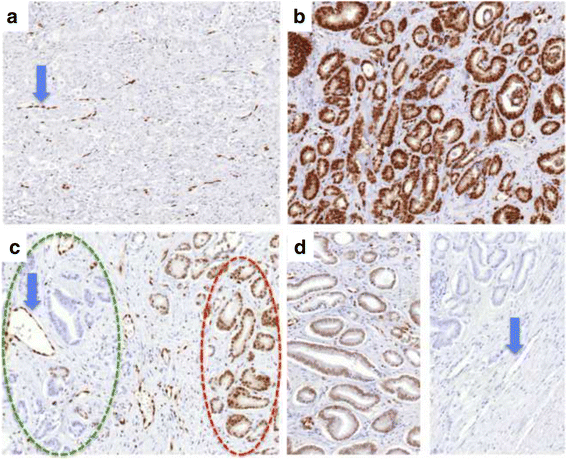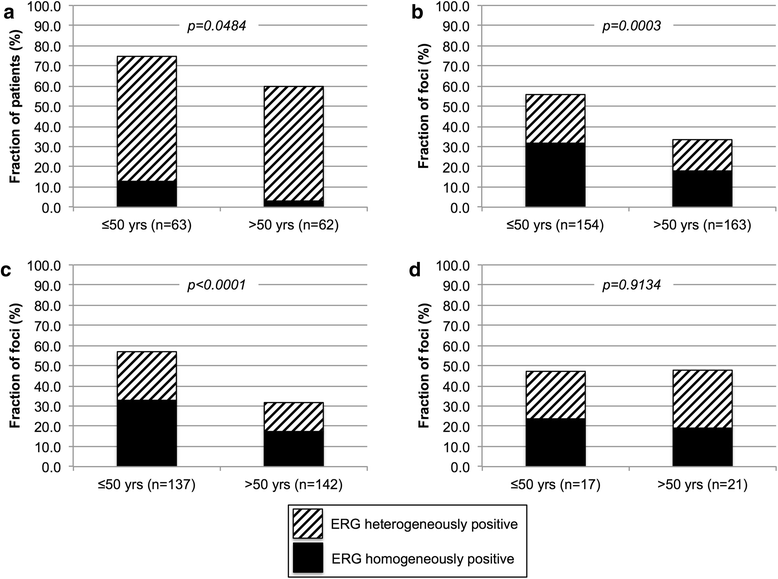Heterogeneity of ERG expression in prostate cancer: a large section mapping study of entire prostatectomy specimens from 125 patients
- PMID: 27530104
- PMCID: PMC4988055
- DOI: 10.1186/s12885-016-2674-6
Heterogeneity of ERG expression in prostate cancer: a large section mapping study of entire prostatectomy specimens from 125 patients
Abstract
Background: TMPRSS2:ERG fusions are frequent in prostate cancer, and occur predominantly in young patients. Several studies had proposed intratumoral heterogeneity of these fusions. This study was designed to determine frequency and extent of ERG fusion heterogeneity in early-onset prostate cancer (EO-PCA, <50 years) and in elderly patients.
Methods: The prostates from 63 EO-PCA and 62 elderly prostate cancer patients were thoroughly reviewed for presence of cancer foci. All 1592 tumor-containing sections were analyzed by immunohistochemistry for ERG expression.
Results: The prostates included in this study contained one tumor focus in 44, two tumor foci in 21, three tumor foci in 32, four tumor foci in 15, and five or more tumor foci in 13 patients. Among 59 cancer foci with ≤3 mm, 19 (32.2 %) were homogeneously ERG positive, 39 66.1 %) were homogeneously ERG negative, and one case (1.7 %) showed a heterogeneous ERG status. The fraction of homogeneously ERG positive cancer foci remained largely constant (14-37 %) with increasing tumor focus diameter but the fraction of heterogeneous ERG findings continuously increased with tumor size and reached 39 % in cancer foci larger than 22 mm. On a patient level, ERG expression was markedly more frequent in EO-PCA than in elderly patients: 13 % of EO-PCA were homogeneously and 62 % were heterogeneously ERG positive. In elderly patients, 3 % of cancers were homogeneously and 57 % were heterogeneously ERG positive (p = 0.0721).
Conclusion: These data show that about 20-30 % of prostate cancer foci have early ERG fusions. ERG fusions further occur in about 50 % of initially ERG negative cancer foci during cancer progression. The vast majority of cancers are heterogeneous for TMPRSS2:ERG fusions on a patient level, challenging the concept of classifying prostate cancer patients into "fusion type" and "non-fusion type" prostate cancer.
Keywords: ERG; Heterogeneity; Prostate cancer.
Figures







References
-
- Gulley J, Figg WD, Dahut WL. Treatment options for androgen-independent prostate cancer. Clin Adv Hematol Oncol. 2003;1(1):49–57. - PubMed
-
- Minner S, Enodien M, Sirma H, Luebke AM, Krohn A, Mayer PS, Simon R, Tennstedt P, Muller J, Scholz L, et al. ERG status is unrelated to PSA recurrence in radically operated prostate cancer in the absence of antihormonal therapy. Clin Cancer Res. 2011;17(18):5878–5888. doi: 10.1158/1078-0432.CCR-11-1251. - DOI - PubMed
MeSH terms
Substances
LinkOut - more resources
Full Text Sources
Other Literature Sources
Medical

